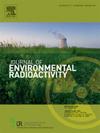利用铯-137测量对栽培有机土壤侵蚀进行探索性研究。
IF 1.9
3区 环境科学与生态学
Q3 ENVIRONMENTAL SCIENCES
引用次数: 0
摘要
对蒙塔姆萨(加拿大魁北克省)栽培有机土壤可持续性的关注,也可以确定为组织有机质,导致了这项探索性研究,旨在通过使用铯-137 (137Cs)测量来量化这些土壤的侵蚀。采用伽马能谱法测定了22个农田有机土壤的137Cs含量。经种植历史调整后的年平均侵蚀率(±SD)在0.4±6.3 ~ 14.6±10.7 t/ha之间。根据从其农场采集样本的农业生产者提供的信息,以及在同一研究区域进行的两项研究,得出的结果低于预期,这两项研究强调了风蚀导致的有机土壤高度损失的重要性。建议制定,以获得更精确的侵蚀率,在未来的研究。本研究还指出了需要进一步研究的方面,以适应现有的转换模型,利用137Cs测量在耕作有机土壤中进行侵蚀评估。本文章由计算机程序翻译,如有差异,请以英文原文为准。
Exploratory study of erosion in cultivated organic soils using cesium-137 measurements
Concerns about the sustainability of cultivated organic soils in Montérégie (Quebec, Canada), which can also be identified as histosols, led to this exploratory study aimed at quantifying erosion in these soils by using cesium-137 (137Cs) measurements. Soil samples were taken from organic soils in twenty-two fields, and their 137Cs contents were measured by gamma spectrometry. The estimated mean annual erosion rates (±SD), adjusted with cropping history, ranged from 0.4 ± 6.3 to 14.6 ± 10.7 t/ha. The results obtained are lower than expected, based on information provided by the agricultural producers from whose farms the samples were taken, as well as two studies conducted in the same study area that highlight the importance of cultivated organic soil height loss due to wind erosion. Recommendations are formulated to obtain more precise erosion rates in future research. This study also points out aspects that deserve to be investigated to adapt existing conversion models for erosion assessment using 137Cs measurements in cultivated organic soils.
求助全文
通过发布文献求助,成功后即可免费获取论文全文。
去求助
来源期刊

Journal of environmental radioactivity
环境科学-环境科学
CiteScore
4.70
自引率
13.00%
发文量
209
审稿时长
73 days
期刊介绍:
The Journal of Environmental Radioactivity provides a coherent international forum for publication of original research or review papers on any aspect of the occurrence of radioactivity in natural systems.
Relevant subject areas range from applications of environmental radionuclides as mechanistic or timescale tracers of natural processes to assessments of the radioecological or radiological effects of ambient radioactivity. Papers deal with naturally occurring nuclides or with those created and released by man through nuclear weapons manufacture and testing, energy production, fuel-cycle technology, etc. Reports on radioactivity in the oceans, sediments, rivers, lakes, groundwaters, soils, atmosphere and all divisions of the biosphere are welcomed, but these should not simply be of a monitoring nature unless the data are particularly innovative.
 求助内容:
求助内容: 应助结果提醒方式:
应助结果提醒方式:


